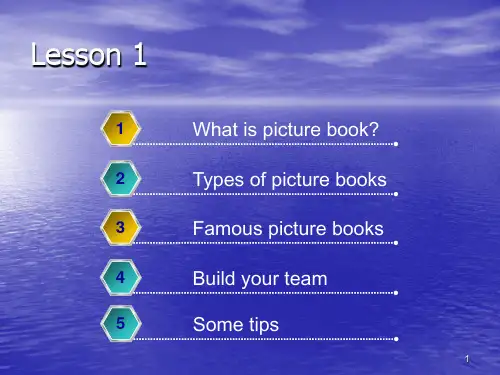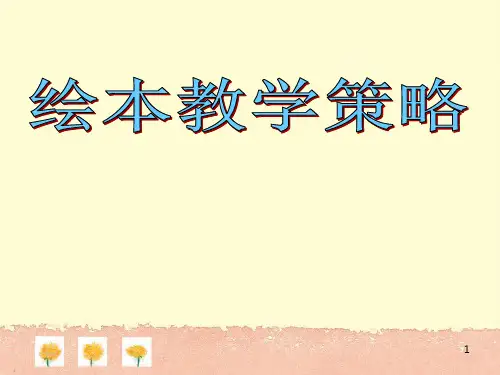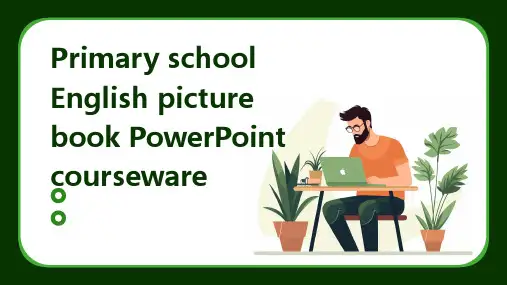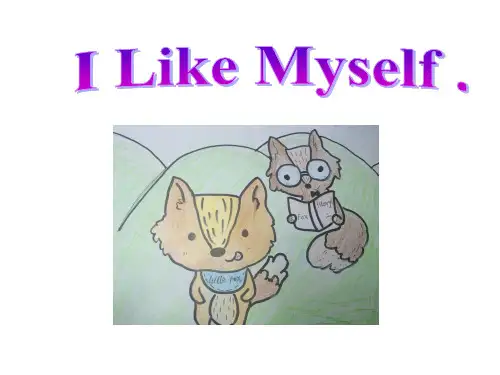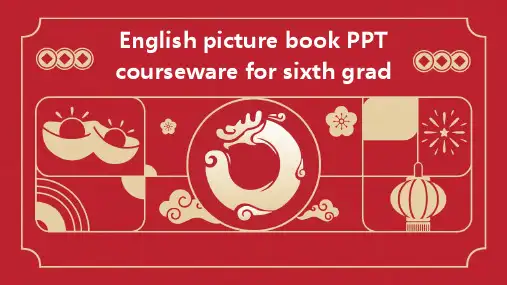英语绘本正式PPT课件
- 格式:ppt
- 大小:16.22 MB
- 文档页数:27

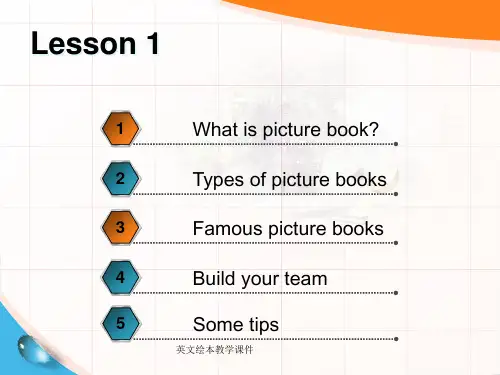
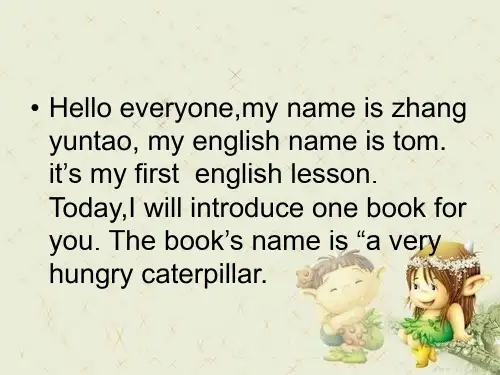

英语绘本mymum课件•Introduction and Background of Picture Books•Text interpretation and appreciation•Exploration of Illustration Art in Picture Books•Theme ideas and educational value mining•Cross cultural comparison and extension•Design and implementation suggestions for practical activitiesIntroduction and Background of Picture BooksOverview of Picture Book "My Mum""My Mum" is an English picture book with the theme ofpraising mothers, showcasing a mother who is bothordinary and special from a child's perspective.In the picture book, the author uses simple and vividlanguage and pictures to depict various images of themother and daily life, expressing the child's deep loveand admiration for the mother.Author Anthony Browne is a famous British children's picture book writer and illustrator, known for his surrealistic style in his works, adept at using symbols and metaphors to express themes."My Mum" is one of Anthony Brown's representative works, inspired by his personal childhood experiences and deep feelings for his mother. Through this picture book, he hopes to guide children to cherish and appreciatematernal love more.Author and creative backgroundThe text in the picture book is concise and clear, rhymes and has a sense of rhythm. It reads aloudand is easy for children to accept and love. At the same time, through vivid pictures and vivid metaphors, help children better understand the content of the text.The picture book adopts a surrealistic style, combining rich imagination and exaggeratedexpression techniques to create a dreamy and infectious visual effect.The screen has bright and vibrant colors, using a large number of contrasting and complementarycolors, making the entire picture book full of vitality and tension.Picture book style and characteristicsText interpretation and appreciation03Plot twistWhen the protagonist encounters difficulties or challenges, his mother provides encouragement and support.01Story openingIntroduce the daily life of the protagonist and mother, showcasing the intimate mother son relationship.02Emotional expressionBy depicting the details of the mother taking care of the protagonist, express gratitude and love for the mother.Story climaxThe protagonist overcomes difficulties and achieves success with the help of his mother.ConclusionEmphasizing the deep emotional connection between mother and son, as well as the significant influence of the mother on the protagonist's growth.Character image analysisMomGentle, considerate, strong, and wise, she is the protagonist's guide andsupporter.The protagonistBrave, persevering, kind, and grateful, gradually growing up under the care of hismother.Other charactersAccording to the needs of the story plot, some auxiliary characters can be set up,such as the protagonist's friends, teachers, etc., to enrich the story content andcharacter images.Language characteristics and expression skills•Vivid Description: Using vivid vocabulary and techniques to enablereaders to deeply experience the story context and characteremotions.•Emotional rendering: By using sentence structures such as exclamationand rhetorical questions, the expression of emotions is enhanced,making readers resonate.•Concise and clear: The language is concise and clear, avoidingexcessive embellishments and complex sentence structures, making iteasy for readers to understand and accept.•Repetition and parallelism: Using rhetorical devices such as repetitionand parallelism to enhance the rhythm and infectiousness of language,leaving a deep impression on readers.Exploration of Illustration Art in Picture BooksAnalysis of illustration style and techniquesWarm and Soft TonesPicture books use warm and soft tones to create a warm atmosphere between parents and children,allowing readers to feel the warmth of home while reading.Vivid character imagesThe figures in the illustrations are lifelike, expressing their emotions and personalities through delicatelines and colors, making it easier for readers to resonate.Rich scene descriptionThe scenes in picture books are rich and colorful, and through delicate brushstrokes and colorrendering, readers are brought into an imaginative world.Illustrations and textcomplement each otherIllustrations and text in picture books complement each other to build a complete story world.Illustrations showcase the story plot through visualimagery, while texts enrich the story's meaningthrough language descriptions.要点一要点二The interpretation and extension of illustrations to text Illustrations not only explain the content of the text, but also extend and expand the text. Through the depiction of illustrations, readers can gain a deeper understanding of the theme and significance of the story.Exploration of the Relationship betweenIllustrations and TextThe role of illustrations in story expressionEnhance the fun of the storyvivid and interesting illustrations can increase the fun of the story, attractreaders' attention, and stimulate their reading interest.Help readers understand the story plotIllustrations showcase the story plot through intuitive visual imagery, helpingreaders better understand the development of the story and the relationshipsbetween characters.Conveying the theme and emotions of the storyIllustrations convey the theme and emotions of the story through visualelements such as color and lines, allowing readers to resonate and emotionalresonance during the reading process.Theme ideas and educational value miningElaborate on the theme and ideasMotherly selflessnessPicture books depict the small sacrifices made by mothers in their daily lives, showcasing the greatness and selflessness of maternal love, and inspiring children's gratitude towards their mothers.The multiple roles of a motherThe mother in the picture book is not only the caregiver of the child, but also the guide and supporter of the child's growth process, reflecting the important role of a mother in the child's growth process.Through reading English picture books, children can learn English vocabulary and expressions in a relaxed and enjoyable atmosphere, and improve their English language abilities.The story plot and characterimages in picture books helpguide children to understand andfeel various emotions, cultivatetheir emotional expression abilityand emotional intelligence.Through the portrayal ofmothers and the portrayal ofstorylines, picture books conveyexcellent qualities such askindness, bravery, and resilienceto children, which helps tocultivate their moral character.Language learning Emotionalcultivation Moral EducationReflection of educational valueInspiration for children's growthGratitude01By reading picture books, children can deeply appreciate thegreatness and selflessness of maternal love, and learn to begrateful and cherish the efforts of those around them.Role identification02The image of mothers in picture books can help childrendevelop role identification, helping them better understand andaccept their gender and family roles.Self growth03By observing and imitating the behavior and qualities ofmothers, children can learn how to face challenges anddifficulties in life, promoting their own growth and development.Cross cultural comparison and extensionComparison of Differences in Family Concepts between the East and the West•Differences in family structure: Chinese families usually attachimportance to the concept of a large family, emphasizing family andkinship relationships; Western families place more emphasis on thenuclear family, which is a small family composed of parents andchildren.•Differences in parent-child relationships: Chinese families emphasizethe authority of parents and the obedience of children, emphasizingfilial piety; Western families place greater emphasis on equality andrespect, encouraging children to express themselves.•Differences in educational concepts: Chinese families generally attachgreat importance to academic performance and talent development,emphasizing the comprehensive development of their children;Western families place greater emphasis on their children'spersonalities and interests, encouraging them to explore freely.Exploring the expression of maternal love in different cultural backgrounds•Differences in expression methods: Chinese mothers usually expressmaternal love by taking care of their children's daily life, payingattention to academic performance, and other means; Westernmothers place greater emphasis on cultivating their children'sindependence and autonomy, encouraging them to explorethemselves.•Expectation difference: Chinese mothers often have high expectationsfor their children, hoping that their children can stand out; Westernmothers place greater emphasis on their children's happiness andmental health, encouraging them to pursue their dreams.•Differences in communication methods: Chinese mothers pay moreattention to listening and understanding when communicating withtheir children, emphasizing emotional communication; Westernmothers place more emphasis on guidance and inspiration,encouraging their children to express their thoughts and feelings.Introduce different culturesIntroduce children to the cultures and customs of different countries throughvarious forms such as picture books, stories, and movies, helping them understand the diversity of the world.Respect cultural differencesEducate children to respect values and lifestyles from different culturalbackgrounds, and avoid stereotypical impressions and discrimination against them.Cultivate cross-cultural communication skillsEncourage children to learn foreign languages and participate in internationalcommunication activities, improve their cross-cultural communication skills and global perspectives.Guide children to understand and respect multiculturalismDesign and implementation suggestions for practical activities•Activity objective: To organize a reading promotion activity for the English picture book "My Mum" to stimulate children's interest in reading, improve their English reading ability, and enhance emotional communication between mother and child/mother daughter.Activity contentReading guide: Stimulate children's interest and curiosity in picture books through a brief introduction and cover interpretation.Reading and explanation: Teachers or parents lead children to read picture books together, explaining the story plot and key vocabulary while reading.Interactive discussionEncourage children to share their understanding and feelings about the story, and raise their own questions or perspectives.Activity formatIt can be conducted in the form of group activities, class activities, or parent-child activities.reading activities•Preparation for co reading: Parents should familiarize themselves with the content of the picture book in advance, understand the background and plot of the story, and prepare for co reading.reading activitiesCo reading processCreate a reading atmosphere: Choose a quiet and comfortable environmentto let children feel the pleasure and relaxation of reading.Interactive reading: Parents can ask questions while reading, guiding theirchildren to participate in understanding and thinking about the story.Implementation suggestions for parent-child reading activitiesEmotional communicationThrough co reading, it enhances emotional communication between parents and children,allowing children to feel the companionship and care of their parents.Post reading activitiesEncourage children to retell stories or express their thoughts and feelings, and also engagein related handicraft or painting activities.books•Preparation for creation: Provide painting materials and paper for children to choose their favorite colors and brushes.booksThe creative processGuide imagination: Encourage children to imagine what their mother looks like,what her characteristics and strengths are.Free Creation: Allow children to freely express themselves and depict their mother'simage in their own way.booksText assistanceFor older children, you can guidethem to add some simple Englishdescriptions or titles.Work DisplayShow the children's works,allowing them to appreciate andcommunicate with each other,improving their confidence andexpression ability.THANKS。
